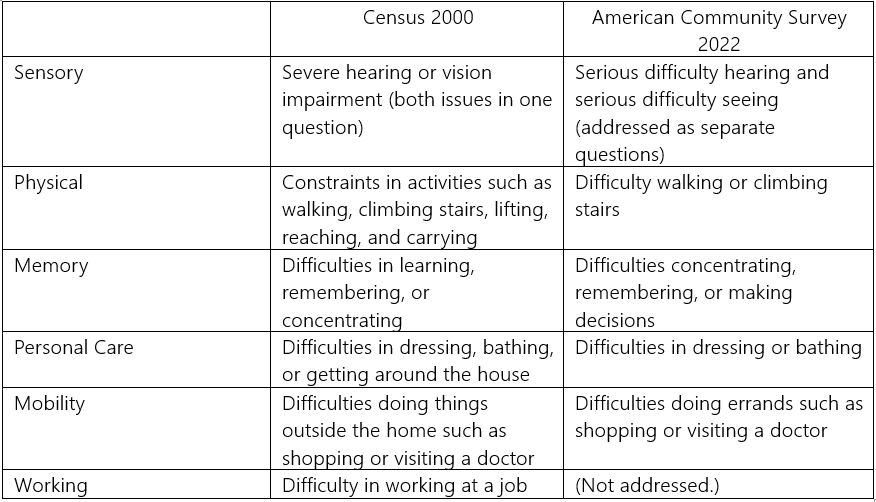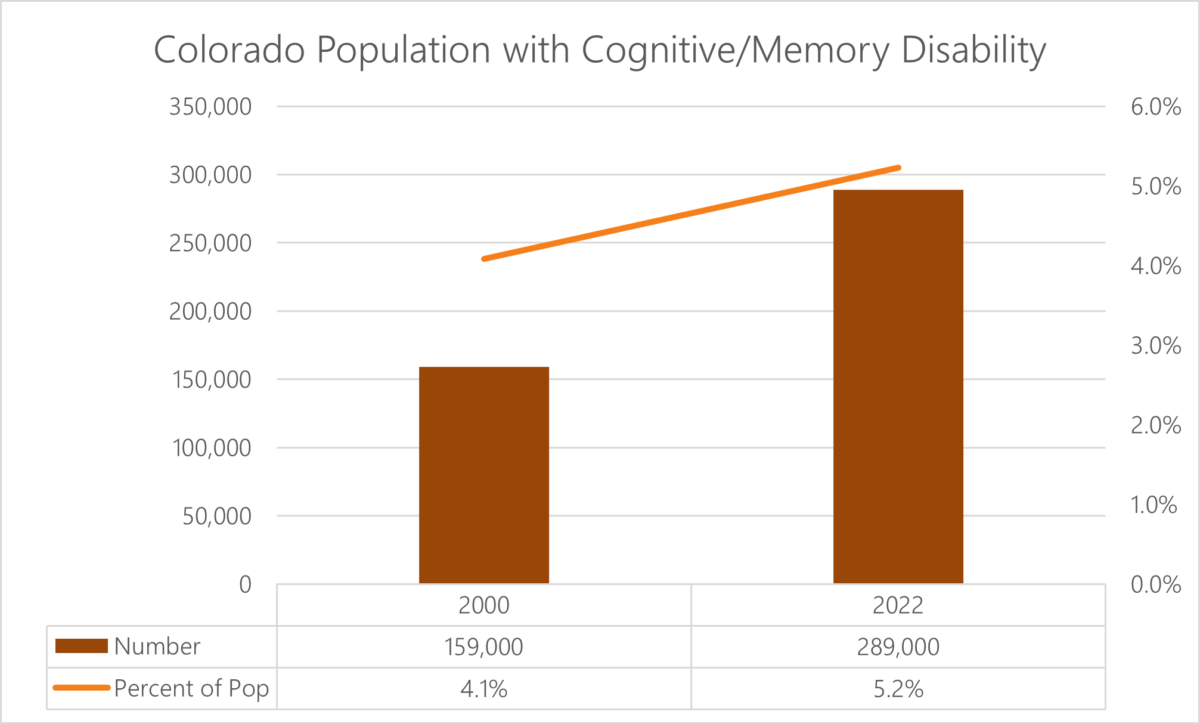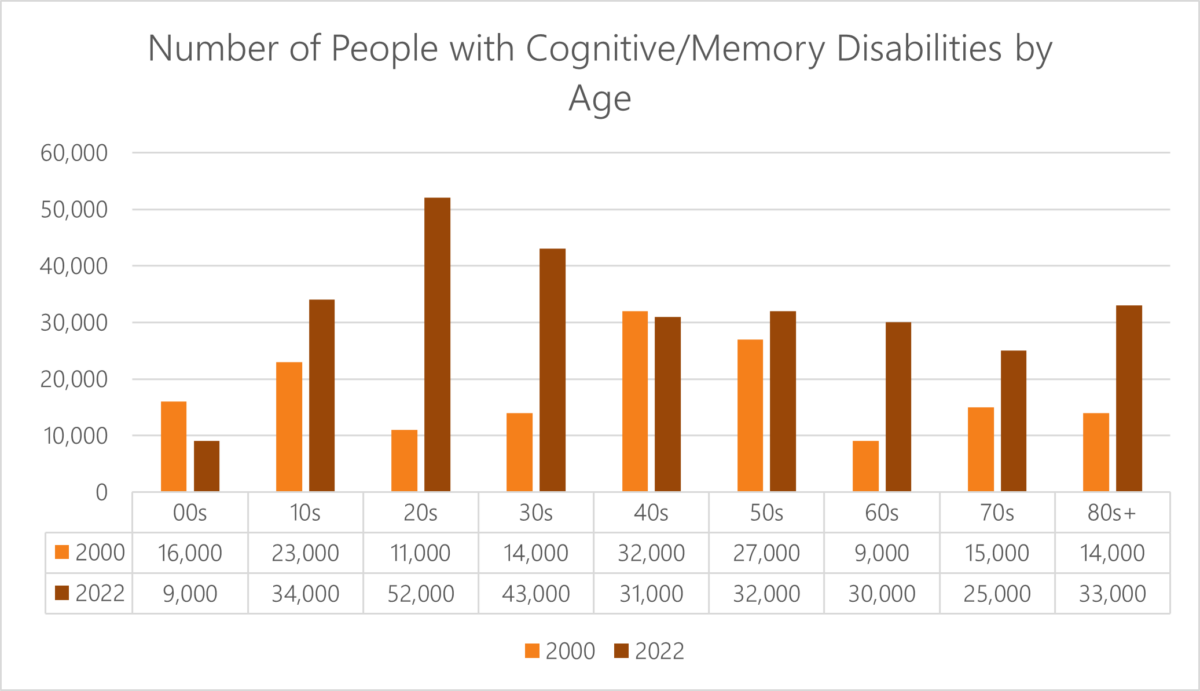25 Years of Change – Cognitive Disabilities
11/20/24 / Corona Insights

As Corona Insights arrives at our 25-year anniversary, we’re looking back to see how our home state has changed over that time*. Included in this series are the following topics:
- Population and Age
- Citizenship Trends
- Sensory Disabilities
- Physical Disabilities
- Cognitive Disabilities (this article)
- Personal Care Disabilities
*Due to data availability the actual period examined in these posts is 2000 through 2022.

Photo by Erik Witsoe on Unsplash
Measuring Disabilities
There are a number of ways to describe and report disabilities, and the US Bureau of the Census has revised their approach over the years. We can see the different methods below.

We have already discussed sensory and physical disabilities. Now we look at the trends we’ve seen in memory/cognition-based disabilities. See the links above where other disabilities are addressed.
Definition Change May Impact Results
The question about memory/cognitive disabilities has changed a bit over time. In 2000, the question was worded as:
Because of a physical, mental, or emotional condition lasting six months or more, does this person have any difficulty in learning, remembering or concentrating?
In 2022, the question has been revised into the following:
Because of a physical, mental, or emotional condition, do you have serious difficulty concentrating, remembering, or making decisions?
The 2022 wording opens the definition to shorter term disabilities, which may lead to people reporting conditions that are more transient in nature, or perhaps conditions that are more independent of age (e.g., depression or anxiety) than traditional age-related issues with memory and cognition. The results below may indicate this, though other interpretations are also possible.
Memory Issues: Not Just for the Elderly
We see that the number of people with this disability has nearly doubled. As with other disabilities, part of this gain is simply the large increase in population. However, another contributing factor is an increase in the prevalence of the disability, from 4.1 percent of the population to 5.2 percent of the population.

As with other disabilities, an obvious suspect is the increase in age of the population. Older people tend to have more disabilities of all types. But here’s where we see a surprise.

At the top end of the age brackets, we see increases in prevalence among those in their 60s and 80s+, but also a decrease among people in their 70s. The baby boom generation is not wildly different than the people who were their age 22 years ago. The GenX generation in their 40s and 50s are actually less likely to see these disabilities than their peers 20 years earlier.
Then we get to the Millennials in their 20s and 30s. This generation is experiencing cognitive/mental disabilities at double to triple the rate that their peers did 22 years ago. This is an outlier that is not reflected in the generation before them or in the generation coming after them. We recognize, of course, that roughly 95 percent of the Millennial population does not claim this disability, but the fact that people in their 20s are claiming this disability at a higher rate than people in their 70s is of interest. Is the issue specific to this generational cohort, and the place and time in which they grew up? Is it an issue in the current day where being in one’s 20s or 30s is particularly difficult? Deeper research is needed to test these and other theories that might describe this phenomenon.
Despite the anomalous findings among people in their 20s and 30s, one still might assume that cognitive and memory issues are an issue of aging, but … nope. The largest population sizes of people with these disabilities are in their 20s and 30s. Those age 80+ have a higher prevalence rate, but the raw population in that age group is smaller. This portends increased mental health needs as the Millennial population grows older and adds the burdens of age to the current cognitive/mental challenges that many face.

Our Conclusions
When we began this analysis, we expected it to be the story of Alzheimer’s and age-related dementia. But this data really tells the story of the Millennial generation, and how the challenges experienced by that age group will likely reverberate for the next several decades.
The Fine Print
As discussed in our post about changes in demographic analysis here, demographic data in the early years of Corona Insights was generally limited to the decennial census, which was conducted in the year 2000. Due to the detailed analysis in many of these posts, we are using analyses of raw data files that were produced from the 2000 Census data. Given that the U.S. Bureau of the Census updated and refined figures after these data were released, some of the data in our analysis may not precisely match the official 2000 figures. For example, the total population of the state was revised upward by approximately 1.2 percent after the raw data files were released. None of these differences are material in our conclusions.
Similarly, the most recent available raw data files are from the year 2022. Therefore, our 25-year analysis actually covers the time period from 2000 through 2022. The world of demographics sometimes requires compromises in the analysis. Such is life.
If you would like to reference this work, feel free to do so. However, please cite the source as Corona Insights and link to this blog post.